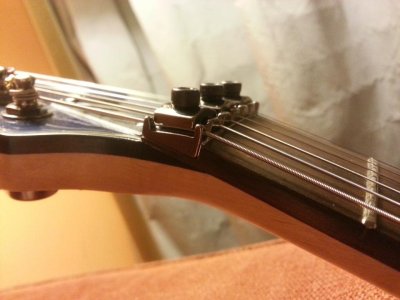Today I intonated my first *nut* in over 25 years of playing. We all know to move the saddles, but moving the nut can be equally important, especially on a guitar that doesn't sound "right". Recent recordings showed subtle shifts in intonation over the length of the neck. Phrases spanning 12 frets or more would shift slightly. The strings are generally in tune against each other anywhere on the neck, so chords sound good, but what I'm talking about is against a reference tone the guitar may become out of tune to varying degrees along the neck.
Some of my guitars are subtly more pleasing and after investigation I found that the ones which sound best have less intonation shift. I am talking generally at most 3 cents in the lower / middle neck and maybe up to 5 cents at the 24th fret. But 3 cents is enough to sour a phrase. 3 Cents is in the realm of how much you can change pitch by applying more pressure to the string. I would say that with jumbos, the difference between light touch and heavy touch may be around 5-6 cents, for point of reference. Obviously this can be overcome with vibrato, but still its best to set up the intonation to the specs that sound best to you.
For the theory of this, read this page which I found: http://www.doolinguitars.com/intonation/intonation4.html
Basically what it comes down to is that to begin, you need to lower your nut as much as possible without getting buzz. Then, when the guitar is perfectly intonated at the 12th fret, if the notes in frets 3-11 are flat, you need to move the nut farther away. (Unless there is something else wrong, you will also see the highest frets going sharp.) If the lower notes are sharp, you need to move the nut closer by filing the nut or the fretboard end.
Manufacturers can compensate (forward) the position of the nut to overcome the sharpening caused by fretting low frets with a high/stock nut. If this is the case, when you lower the nut, you may also need to move the nut farther away.
In the picture I created a shim by using folded aluminum foil. This shim is about 6-8 sheets thick, but it made a great improvement. This is very easy to do with a Floyd nut because they bolt or screw on - you can fit a shim quickly and then intonate the guitar to see if it is playing better, and then make an educated guess how thick the final shim sould be. My inexpensive Dean 350 guitar now intonates with the best of them! I still need to do a few of my Ibanez guitars.
The takeaway from this, my opinion.. is that each player will have a preference based on how much pressure he generally applies, and how high his nut is. The amount that I needed to move the nut is probaby hard to control with factory guitars, so some guitars will come off the line intonating better, imo. It may also be choice of the builder how much the nut is compensated.
This can be taken to a whole other level by compensating individual strings, but anyone with a Floyd guitar - especailly a cheap one - owes it to themselves to try moving the nut to see if it can improve your guitar. The operation is a little more involved with standard nuts because glue is ultimately involved.
Post will probably get buried, but this might help a few people. Enjoy.

Some of my guitars are subtly more pleasing and after investigation I found that the ones which sound best have less intonation shift. I am talking generally at most 3 cents in the lower / middle neck and maybe up to 5 cents at the 24th fret. But 3 cents is enough to sour a phrase. 3 Cents is in the realm of how much you can change pitch by applying more pressure to the string. I would say that with jumbos, the difference between light touch and heavy touch may be around 5-6 cents, for point of reference. Obviously this can be overcome with vibrato, but still its best to set up the intonation to the specs that sound best to you.
For the theory of this, read this page which I found: http://www.doolinguitars.com/intonation/intonation4.html
Basically what it comes down to is that to begin, you need to lower your nut as much as possible without getting buzz. Then, when the guitar is perfectly intonated at the 12th fret, if the notes in frets 3-11 are flat, you need to move the nut farther away. (Unless there is something else wrong, you will also see the highest frets going sharp.) If the lower notes are sharp, you need to move the nut closer by filing the nut or the fretboard end.
Manufacturers can compensate (forward) the position of the nut to overcome the sharpening caused by fretting low frets with a high/stock nut. If this is the case, when you lower the nut, you may also need to move the nut farther away.
In the picture I created a shim by using folded aluminum foil. This shim is about 6-8 sheets thick, but it made a great improvement. This is very easy to do with a Floyd nut because they bolt or screw on - you can fit a shim quickly and then intonate the guitar to see if it is playing better, and then make an educated guess how thick the final shim sould be. My inexpensive Dean 350 guitar now intonates with the best of them! I still need to do a few of my Ibanez guitars.
The takeaway from this, my opinion.. is that each player will have a preference based on how much pressure he generally applies, and how high his nut is. The amount that I needed to move the nut is probaby hard to control with factory guitars, so some guitars will come off the line intonating better, imo. It may also be choice of the builder how much the nut is compensated.
This can be taken to a whole other level by compensating individual strings, but anyone with a Floyd guitar - especailly a cheap one - owes it to themselves to try moving the nut to see if it can improve your guitar. The operation is a little more involved with standard nuts because glue is ultimately involved.
Post will probably get buried, but this might help a few people. Enjoy.


